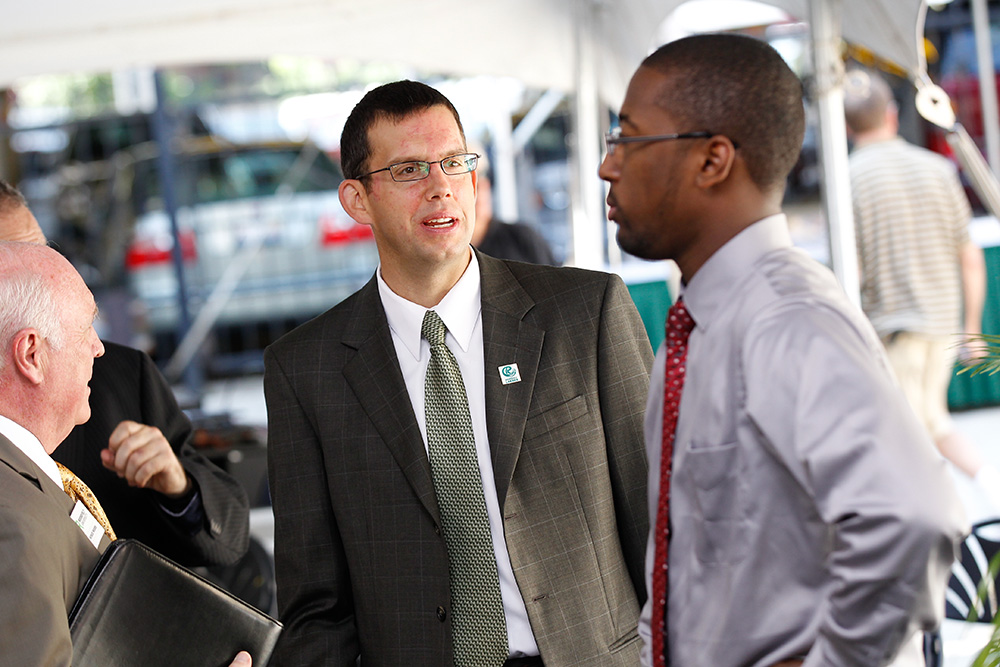Q&A with Athletic Director Mike Cassidy
By Abbas Haleem
Seven years ago, Mike Cassidy walked the perimeter of a parking lot on the southeast corner of Congress and Wabash, wondering how an athletics center could fit there.
Roosevelt University had just hired him to bring varsity athletics back after a 20-year hiatus. His charge: to reintroduce men’s sports and to start women’s sports for the first time.
He was told, “A year from now, we want to have intercollegiate athletics.”
Two and a half years later, on Dec. 1, 2012, the Lakers held their first basketball game at the $5 million Goodman Center.
Since Cassidy switched from the University of Illinois at Chicago to Roosevelt, he has introduced 14 intercollegiate teams and filled his tidy office with Lakers memorabilia. On his desk: A 1959 tennis trophy engraved with alumni names such as Emmanuel “Mike” Agassi, Andre Agassi’s father. In an interview at the Goodman Center, Cassidy discussed the challenges of building a program. Excerpts:
Q: Where did you practice at first?
We played a year at [the Illinois Institute of Technology, then] a year at what was formerly Attack Athletics, which is now Hope. We practiced a lot at UIC. That’s where I came from, so I have relationships with a lot of the people over there.
Q: And how much did you help with designing the Goodman Center?
I’m not an architect, so obviously we hired some professionals to do it, but I was working with them step-by-step on what needs to be in the facility. Then they’d come back with a drawing. “Well, we need more bathrooms.” Then there’s code. I learned a lot about what it takes to build something in the city.
Q: Did you know at the time that the Goodman Foundation would fund the construction?
No, at the time, that part was not solidified yet. That was something that came up pretty early on, though, in the process. They [Larry and Lillian Goodman] had an interest not only in the athletic portion, but in the naming-rights portion. [We also collaborated on] some other drug awareness, drug prevention [and] drug education initiatives. They also had an interest in health and wellness and what this building could be used for, not only from an intercollegiate athletic aspect but for all of our students to use.
Q: Did they tell you how they would distribute funds for the program?
Nope. That was probably challenge No. 2 if not challenge No. 1. There’s no book out there that says this is how much it costs to start an athletic program in an urban setting with no facility space. A lot of things, in my 11 years at UIC, I just took for granted because we just had it. We had space. We had facilities. Whereas here, “Wait, I need to transport our students to and from practice here, there and everywhere,” so that’s going to be expensive. We don’t have any on-campus parking, so how do we deal with those issues? Where are we going to wash our uniforms? And how are we going to wash our uniforms on a daily basis? We don’t have laundry facilities here on campus. Where are kids going to shower? Where are they going to work out? We didn’t have any of these things that are normal for an athletic department to have. We didn’t have one piece of equipment, so how much was each piece of equipment that it takes, how much was all that going to cost? Every day of my first three or four months was really about trying to piecemeal all that together.
Q: When I went to Columbia [College], people didn’t know we had sports teams. Are you facing something similar here at Roosevelt?
Yes. I think it’s an ongoing education of people understanding, “Oh, this is a something.” I think it’s one of the biggest reasons why we try to make sure our kids are wearing Roosevelt Lakers apparel. We have an internal rule of, “We don’t want you wearing other college’s stuff. You are our greatest billboards. When you’re in class, when you’re on campus, wear our stuff. The only way we’re going to become cool is if you make us cool.” My cool card has been revoked. I think once you turn 40, you’re not cool anymore. So it’s up to them. They’re going to be the ones who are walking up and down State Street and the Magnificent Mile, and people are going to go, “Oh, that logo. That’s cool. It’s Roosevelt.”
Q: Where is the program right now in terms of development?
We’ve grown out of the startup phase, and now we just need to figure out who we want to be in terms of our stake in the marketplace.
Q: What’s the next step for athletics at Roosevelt?
We need to solve our outdoor facilities space issues. We have no Goodman Center [for] outdoor sports — obviously a huge challenge given the lack of green space in the city and the cost. This is not the suburbs. That’s a huge challenge for us, but it’s one I always have an eye on. [I also want] to tie our history to our present. There’s more alumni I want to meet. There’s more people I want to make aware that we’re back.

